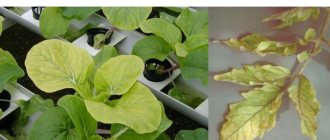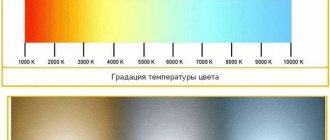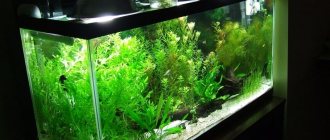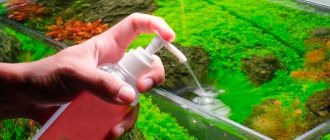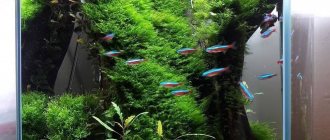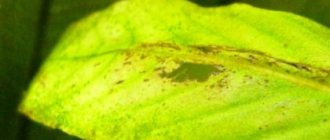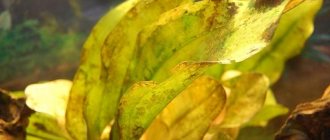The speed of plant response to changes in the nutrient medium does not manifest itself in the same way and depends on the type of plant. For example, mosses, rotals, blixa, staurogyne, limnophila and pinnate will feel imbalanced within a few days. Less efficient:
Cryptocorynes
Echinodorus
Bolbitis
fern plants
It takes them about a week to realize that something is wrong with their diet. Aroid plants, such as anubias, may notice instability in the nutrient medium only after 15 days.
We will look at the main nutrients and how plants behave when they are deficient.
The role of iron in a planted aquarium
Iron plays an important role in plant physiology. Based on the amount of iron consumed by plants, it can be classified not as a micronutrient, but as a macronutrient. However, it is usually included in microfertilizers due to its ability to interact with phosphates. A lack of iron very quickly affects the appearance of aquarium plants. A very characteristic sign is chlorosis - yellowing of the leaf blade between the veins (2-3 leaves after the youngest). In the future, necrosis of the plant leaf is possible. All these signs are accompanied from the earliest stages by a significant slowdown in growth. To prevent this from happening, fertilizers that contain iron are added to the aquarium with plants.
Harm to the health of non-target organisms
Some fish species are very sensitive to copper and will die even at concentrations below therapeutic levels (i.e., less than 0.15 mg/L). Very important factors in the survival of fish are the acclimatization period, when the fish is exposed to gradually increasing concentrations of ions over several days, as well as the stage of the life cycle of the individuals. For example, in some species, eggs adapt to copper much faster than fry or adults and have a greater survival rate. In other fish species the opposite is true. Copper toxicity manifests itself in damage to the gills, liver, kidneys, immune and nervous systems. In this case, the gills are most affected. This respiratory organ becomes denser, thickens and loses the ability to regulate the exchange of ions between the external environment and the internal environment of the body. This metal also suppresses the functions of the immune system and lateral line. Long-term exposure to copper can lead to a decrease in the growth rate of an individual. When poisoned, in addition to the primary sign of distress (rapid breathing), the fish will darken and begin to exhibit behavioral characteristics including incoordination and drowsiness. Ultimately, such a course of poisoning leads to death.
Most invertebrates are very sensitive to copper and are unable to survive treatment with this element. Therefore, during the procedure, they must be caught from the reservoir and placed separately. They will be able to return to their home only when the metal concentration is less than 0.01 mg/l. After treatment, it is necessary to check its level several times, because this element tends to accumulate in various parts of the reservoir (for example, on decorations) and is gradually released from there when the pH of the environment changes.
What kind of iron is there, and what kind of iron can be used in an aquarium
Before writing about the form in which iron comes, I would like to raise the following problem. Namely, in the aquarium community there is a misconception that there is divalent iron, which is suitable for feeding aquarium plants, and a second type of iron - trivalent iron, which is supposedly insoluble and cannot be used as a fertilizer. This is not true. In fact, both ferrous and trivalent iron can be found both in the form of water-insoluble salts and in the form of soluble salts. And both iron - divalent and trivalent - can be used as fertilizer for plants. Moreover! Bivalent iron does not have a significant advantage over ferric iron in terms of efficiency of use in plant aquariums for the following two reasons: 1) only a small proportion of divalent iron reaches the plant in the aquarium, without having time to be oxidized by oxygen (there is usually a lot of it in a planted aquarium) to ferric iron; 2) aquarium plants consume ferric iron without any problems. Therefore, it does not really matter which iron to use, trivalent or divalent. The main thing is that the iron is in dissolved form and does not settle in the form of oxide before the plant absorbs it. But chelators help us with this. It is not the degree of oxidation of iron that determines its solubility and availability by plants, but whether it is chelated or not. Therefore, the difference between iron for aquarists comes down to two types of iron: unchelated iron, which tends to quickly precipitate in the aquarium, and chelated iron, which is available to plants.
Effect of copper on parasites
At recommended concentrations (0.15-0.20 mg/l), copper is toxic to a number of fish parasites, including the marine parasites Cryptocaryon irritans and Amyloodinium ocellatum. First of all, it is good at fighting the infectious stage, when pathogens are still floating freely and have not come into contact with the host. Thus, understanding their life cycle is very important for calculating the duration of procedures. For Cryptocaryon, procedures must be carried out for at least 3 weeks. And for Amyloodinium it is about 10-14 days.
Iron chelates, their stability and suitability for use in the aquarium.
Chelators used in the aquarium hobby can be divided into two categories. The first category is biologically stable, which form strong chelates with metals (in our case it is iron, chelation of manganese is also important). This category includes EDTA, DTPA and chelators with similar structures. Some of them are better for aquarium plants, some are worse in terms of ensuring a stable concentration of iron in the aquarium, but all of them can accumulate (since they are biologically stable).
Another category is biologically unstable chelates. These are the ones that are quickly (depending on the chelator, 1-100 days) eaten by bacteria in the aquarium. These include iron gluconate, iron fumarate, iron citrate (from citric acid), glycinates (from glycine or aminoacetic acid). They do not accumulate in the aquarium, but at the same time they cannot provide a stable concentration of iron in the aquarium, because these particular iron chelates are not as strong as in the case of the first category of chelates.
If an aquarist prepares fertilizers with his own hands, then he will have to choose the iron chelate that suits him best (in terms of ease of use and effectiveness for a particular aquarium). Or follow the path I propose - a universal mixture of iron chelates: iron DTPA + iron gluconate. Readers may be wondering why this particular mixture seems optimal. I will share some of my results comparing Trilon, DTPA, HEDP and gluconate.
Why I left Trilon (EDTA), I think, there is no need to explain for a long time. I have already written about this several times. Trilon accumulates because the bacteria in the aquarium do not like it. And this problem is aggravated when the aquarium has hard water above pH 7, since for such aquariums more iron chelate on Trilon needs to be poured. This had no effect on simple plants. But when switching to complex rotals, and even blixa, symptoms similar to calcium deficiency may appear. Radiculitis in the indicated long-stemmed plant, white leaves in blixa.
It would seem that DTPA is similar in structure to Trilon and why shouldn’t it also accumulate. But no, apparently its metabolism with the participation of the aquarium microflora is not as energy-intensive as with Trilon and goes better. On DTPA I did not have such problems with complex plant species as in the case of Trilon. But after a long time (6-8 months), radiculitis began to appear from time to time in some aquariums. This happened only on forced herbalists, that is, on those in which the doses of fertilizers were large. That is, there is still some accumulation. That's why I came to iron gluconate. More precisely, a mixture of iron DTPA and iron gluconate.
How did iron gluconate itself behave? For plant aquarium enthusiasts, I think this is an ideal source of iron. I emphasize, for the fans. The fact is that iron gluconate is a source of iron for one day. He doesn't live in an aquarium for long. Like any other “sugar,” gluconate is very quickly eaten by bacteria, and therefore needs to be added every day. In slower herbals, the plants may suffer a little and chlorosis will not appear until a few days after the gluconate is added. With gluconate you can notice a very interesting phenomenon. Iron gluconate is consumed by plants very quickly and you can even notice how the color of the leaves changes towards green within 1-2 hours. As expected, there were no radiculitis, white leaves, or other surprises from the use of iron gluconate.
Sometimes, as a cheap alternative to gluconate, a chelate with similar properties, glycinate, is used. But its similarity to gluconate in an aquarium is expressed only in the rapid decomposition by bacteria (and, therefore, non-accumulation in water) and the instability of the iron chelates it forms. An effect on plants similar to that of gluconate should not be expected from iron glycinate. I attribute this to the fact that the structure of gluconate is similar to the structure of carbohydrates (sugars), which are evolutionarily easier for plants to consume. Suffice it to remember that the main source of carbon when growing meristem plants is sugar. Unlike gluconates, glycinates are amino acid chelates. In terms of structure, glycinates are closer to EDTA and DTPA chelates, which are also amino acids. But chelates based on glycinates are much less stable than chelates based on DTPA or even EDTA. Therefore, if you were attracted by the cheapness of the option of making your own iron chelate based on glycine, then it is better to consider another cheap chelate - citrate (based on citric acid), the recipe for which is presented at the end of the article.
Comparing the observations I described above, you can guess why I came to use a mixture of chelates. It is a mixture of ferrous gluconate and ferrous DTPA. In fact, the iron gluconate in the mixture dilutes the DTPA and prevents it from building up. In my experience, boosted herbalists have had no problems with my mixture for 3 years compared to 100% iron DTPA. DTPA, in my opinion, is mandatory for use in a chelate mixture because it is more stable than gluconate and always maintains the minimum required iron concentration. If you use only iron gluconate as a chelator, or especially its cheap analogue glycinate, then it is extremely difficult to provide constantly available iron for aquarium plants. The only way out can be a significantly increased dosage of such chelates. But this is not rational.
There remains one more person involved in the study - OEDF. Available in the form of REAKOM fertilizers, and therefore relatively popular among aquarists. Why didn't I include it in my chelate mixture and why am I so skeptical about it? Iron chelate with HEDP is somewhat similar to iron gluconate, only it is still more stable than gluconate. And it does not need to be added every day like gluconate. In addition to all this, it has not yet accumulated. It would seem like an ideal option. Moreover, for folk self-mixes it can be used in the form of an affordable fertilizer, Reacom. There is one more BUT. Take a look at the HEDP molecule. It has two phosphorus atoms and these two phosphorus, as HEDP decomposes in the aquarium, will turn into two phosphate ions. That is, for every iron ion added with HEDP, two phosphate ions are added. For a better understanding, I will give a calculation. Let's say we need to add 1 mg/l of iron per week. If we do this using iron chelate with HEDP, then during the same time we add 3.4 mg/l of phosphate. I consider it sufficient to add 2 mg/l of phosphate per week, even for an aquarium with plenty of light, plants and a CO2 supply, and I take this as the norm. More phosphate is needed only for the rapid growth of plants for the purpose of cultivating them for sale. That is, in the case of HEDP, the situation looks like this: 1 mg/l/week of iron, 3.4 mg/l/week of phosphate at a rate of 2 mg/l/week of phosphate. The norm is 100%, HEDF makes 170% even without adding MACRO with phosphates. It can be stated that iron chelate with HEDP is more a source of phosphorus in the aquarium than iron. For comparison, I will give the same calculation for the case of iron chelate with DTPA. DTPA contains nitrogen and can introduce it into aquarium water in the form of nitrate or other ions. If we add 1 mg/L of iron per week exclusively as DTPA chelate, then we also add a nitrate equivalent of 3.3 mg/L. For the type of aquarium under discussion, I believe the norm is 20 mg/l per week of nitrate. That is, in the case of DTPA. 1 mg/l/week iron, 3.3 mg/l/week nitrate at a rate of 20 mg/l/week nitrate. The norm is 100%, DTPA makes 17%. As I wrote above, adding iron exclusively in the form of DTPA is not optimal. Better mixed with gluconate. And such a mixture will additionally introduce a nitrate equivalent of about 1 mg/l/week at a rate of 20 mg/l. This, of course, needs to be taken into account, but in practice 1 in 20 is the order of the error in applying fertilizer with a pressure dispenser. As for my observations during the use of iron chelate with HEDF, I noticed the following. HEDP is quite stable and does not decompose immediately after being added to the aquarium. That is, by adding iron, phosphates jump up with a delay. This delay is unstable and uneven. The plants did not seem to be outraged by this. They grew well and even too quickly (of course, there are a lot of phosphates). But it often happened spontaneously that phosphates jumped sharply (active decomposition of HEDP due to jumps in the activity of microflora), the growth rate of plants increased, CO2 was consumed faster and I did not have time to adjust its supply. As a result, a number of factors came together for a short period of time: high concentration of phosphates, low concentration of CO2, high pH, which led to the very rapid appearance of algae in the form of a green coating on the walls and stones.
Let's look at some of the most popular chelates.
Iron citrate (chelate from citric acid) and iron glycinate (from glycine) are weak chelates that fall apart in the aquarium within a few hours, but are used with success by some aquarists. In addition, the chelator itself, after the plant takes iron from it, does not remain in the aquarium for a long time, as it will be eaten by bacteria.
Ferrous gluconate (from gluconic acid) is considered one of the best chelates when added daily to the aquarium. Firstly, the gluconate has iron in its divalent form (as we said - a small, but still an advantage). Plants absorb it well. The chelator itself is a glucose derivative, i.e. sugar, which is instantly eaten by bacteria. Perhaps the only drawback of iron gluconate is that it is not very stable in the aquarium. The next day it must be added again.
Fe-EDTA (from Trilon-B) is one of the most common chelates due to its availability, ease of DIY production and relative strength. But it is durable only in an acidic environment (at pH<7). This acidity usually occurs in aquariums with fairly soft water (KH<4) and an organized supply of carbon dioxide (CO2). If pH>7, then this chelate disintegrates within a few hours. It has one more drawback - having broken down into iron and Trilon-B, the latter, instead of iron, binds calcium and magnesium ions into its molecule, reducing their concentration in water, which can lead to undesirable consequences for plants (in particular, radiculitis may appear).
Fe-DTPA is somewhat similar to Fe-EDTA, but its main advantage is that it is much more stable at water pH >7. In addition, it causes radiculitis in plants to a much lesser extent when it accumulates in an aquarium.
Fe-HEDP (from HEDP acid) is a fairly stable chelate at pH>7 and is well absorbed by plants. Does not accumulate in the aquarium, because HEDP acid gradually breaks down into its components. But it should be borne in mind that it contains phosphorus, which may require adjustments in the application of phosphates in the form of fertilizers.
How to make fertilizer with iron yourself
Not many aquarists can afford chelates such as iron gluconate and iron DTPA. Therefore, these chelates are usually included in commercial fertilizers, whose manufacturers order them in large quantities. But if an aquarist wants to experiment with his plants, then he has such an opportunity, and in the form of a budget option. All he needs is iron sulfate from the garden store, citric acid, distilled water (or water after a reverse osmosis filter) and a kitchen scale.
In 500 ml of distilled water you need to dissolve: 20 g of citric acid (chelator). A smaller amount of citric acid is sufficient. The excess is used to compensate for some time for the decomposition of citric acid in the solution. After dissolving the citric acid, you need to dissolve 20 g of iron sulfate. The result is a yellow solution with an iron concentration of 8 g/l, which can be stored in the refrigerator for about a month without loss of quality. In order to calculate the dose of this fertilizer for your aquarium volume, use the fertilizer calculator (at the end of the article).
Chelates
Chelating agents help maintain copper levels in water by forming a structured complex with the element. These complexes vary in their stability depending on the agent. For example, the agent EDTA (ethylenediaminetetraacetic acid) behaves quite stably in solution. You can also use citrate, but it is less stable. On the other hand, complexes of citrate with copper have more pronounced biological activity than EDTA and are easier to remove from water after the procedure is completed.
However, copper sulfate is more common in aquaculture because it is easier to control than chelating agents, whose strength and potency are more uncertain than copper sulfate and are more difficult to remove from the water.
How much iron to add with fertilizers
You can proceed from the following dosage: 0.5-1 mg/l should be added per week of iron. This is for aquariums with CO2 supply. And for such aquariums it is better to add iron daily, dividing the indicated weekly dose into 7 days. For aquariums without CO2, you can add less iron and less frequently. For such aquariums, iron in tap water already has a significant effect. Remember, the best indicator is plants. Young leaves, or rather even the second or third leaf, are chlorositis (turn yellow), which means there is not enough iron. Plants react literally the next day by greening their leaves when the dose of iron is increased - this does not happen with any other nutrient. Here's your indicator.
As for an overdose of iron, it is difficult to achieve in the practice of using liquid fertilizers. Excess iron is leveled by the fact that it is gradually consumed or lost. Therefore, there is no need to be afraid of this. The exception is those cases when tap water (usually from a well) contains a lot of iron - up to 2 mg/l or more. Aquarium plants grow very poorly in such water.
Active ingredient
Copper is a heavy metal that can exist in various forms. The most effective state of copper for algae and parasite control is charge 2+ (Cu2+). In this form, the metal is found in copper sulfate, which is also known as copper sulfate pentahydrate because it binds five molecules of water.
When copper sulfate is dissolved in water, it breaks down into individual Cu2+ ions and SO42- ions. Since copper is the active ingredient in copper sulfate, which remains in aqueous solution, the concentration of Cu must be measured. For susceptible marine parasites, including Amyloodiniu and Cryptocaryon, it should be 0.15-0.20 mg per liter of water.
For many reasons, maintaining copper ion levels can be challenging. Water has many dissolved substances in it, such as bicarbonate ion (HCO3-), which easily combines with copper and “removes” its ions from solution. Carbonates that are part of dolomite, crushed corals, and sea shells dissolve in water and bind to Cu2+, thereby changing its concentration. In addition, many living organisms, including bacteria, algae and shrimp, as well as some substrates such as activated carbon, absorb copper.
However, there are other factors that can lead to a strong increase in the concentration of this metal. An increase in salinity reduces the binding (absorption) of copper from the surface. In salt water at a neutral pH level (around 7), copper is surrounded by chloride molecules. Acidification results in the release of previously bound molecules, increasing the risk of damage to organisms. In addition, living organisms such as shrimp accumulate copper, and if they are later eaten by fish, the latter may become poisoned.
Environmental influence
Factors determining the toxicity of copper in water:
1) amount of free ion (Cu2+); 2) sensitivity of fish and invertebrates; 3) age of the fish; 4) acclimatization; 5) the presence of a specific substrate, especially calcium and magnesium carbonate; 6) the presence of dissolved substances, incl. carbonates, which, by binding to copper, reduce its pure concentration and potency; 7) the presence in the reservoir of organisms that are capable of bioaccumulating (accumulating) copper in their bodies (shrimp, crayfish, etc.); the presence of a water acidity regulator. Copper concentrations can change over time, for example suddenly increasing during pH drops. However, it must be measured at least twice a day and, accordingly, it must be adjusted (see section below). Interaction with bacteria
2) sensitivity of fish and invertebrates; 3) age of the fish; 4) acclimatization; 5) the presence of a specific substrate, especially calcium and magnesium carbonate; 6) the presence of dissolved substances, incl. carbonates, which, by binding to copper, reduce its pure concentration and potency; 7) the presence in the reservoir of organisms that are capable of bioaccumulating (accumulating) copper in their bodies (shrimp, crayfish, etc.); the presence of a water acidity regulator. Copper concentrations can change over time, for example suddenly increasing during pH drops. However, it must be measured at least twice a day and, accordingly, it must be adjusted (see section below). Interaction with bacteria
In addition to pathogenic organisms, copper is harmful to nitrifying bacteria. A concentration of 0.3 mg/l of copper sulfate inhibits the oxidation of ammonia and nitrites, so monitoring their content in water is required. Some bacteria that cause diseases in fish are very resistant to copper, for which the lethal concentration is about 1.25 mg/l.
Determination of concentration
Copper sulfate consists of only a quarter of pure copper, which is the most important element in the process of water purification. Copper sulfate dosage is based on the portion of pure copper in solution needed to clear parasites, including Cryptocaryon and Amyloodinium. The concentration of Cu2+ ions should be about 0.15-0.20 mg/l.
To determine the required amount of copper sulfate (in grams) for a given volume of water, you can use the following formulas:
Volume of water in liters × required concentration of pure copper (mg/l) × 0.00392 = required mass of copper sulfate (grams).
Example: 1000 liter system required free copper concentration: 0.20 mg/l
According to the above formula: 1000 l × 0.20 mg/l × 0.00392 = 0.784 g copper sulfate.
When using metal in higher concentrations, follow the manufacturer's instructions.
Removing copper from water
Activated carbon does an excellent job of purifying water from Cu2+ ions. One way to remove this element is to place a separate filtration unit containing fresh activated carbon at the rate of 170 grams per 57 liters of water. As soon as the water goes through a full filtration cycle, it is necessary to measure the metal concentration. If chelated copper compounds were present in the water, then it must be completely replaced. Dolomite can be used as a cleaner, but it will also need to be removed. If measurements continue to show high levels of pure copper, a complete water change may still be necessary. The level of concentration must be measured both during the process of its removal and within several weeks after its completion, since the copper accumulated in the decorations and soil is released gradually.
